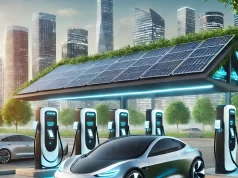Over time, Tesla has continued to enhance the technology behind its superchargers, resulting in faster and more advanced charging capabilities.
The original V1 Superchargers provided a charging speed of 100 kW, but this was improved to 120 kW with the introduction of V2.
In 2019, V3 was launched, boasting more than twice the charging speed of its predecessor at 250 kW.
Now the latest version of Tesla’s Superchargers, V4 can charge the Semi at speeds of up to 1 MW.
The V4 Superchargers implement lighter and thinner cables, as well as liquid cooling, to increase efficiency and provide charging speeds of up to 1,000 miles of range per hour.
One of the standout features of the V4 Supercharger is its taller charging stall, which includes a much longer cable than the previous V3.
Tesla introduced the latest variant of the Tesla Supercharger to Europe earlier this year, with the first “V4” charging station placed in the Netherlands.
These Tesla Superchargers are classified into four generations: v1, v2, v3, and v4.
In this article, we’ll take a closer look at the differences between each generation of Tesla superchargers.
Before that, let’s look at the key differences between Tesla V4, V3, V2, and V1 superchargers.
| Model | Power Output | Charging Speed | Cable Length | Cooling System |
|---|---|---|---|---|
| V4 | 350 kW | 250 miles in 15 Min | 3 meter | Liquid-cooled |
| V3 | 324 kW | 180 miles in 15 Min | 1.5 meters | Liquid-cooled |
| V2 | 150 kW | 170 miles in 30 Min | 2.7 meters | Air-cooled |
| V1 | 120 kW | 170 miles in 30 Min | 2.4 meters | Air-cooled |
V1 Supercharger
Tesla’s first-generation Supercharger was launched in 2012, with a charging capacity of up to 120 kW.
The v1 Supercharger is compatible with Tesla Model S and Model X, offering a range of approximately 170 miles in just 30 minutes of charging.
The V1 charger is quite similar to the home charger or destination charger, both of which operate on 240V with a 50Amp capacity.
Depending on the capacity of your EV’s battery, it typically takes around 8-10 hours to charge 80% of the car’s battery.
When only one car is connected, both V1 and V2 Superchargers can run at a maximum of 150kW DC.
However, the more advanced V3 chargers can reach up to 250kW.
It is essential to note that when a second Tesla connects to a fast charger, the maximum charging rate on the first car may decrease, despite prioritizing the first car’s charge time.
The charging rates for a single vehicle connected to an EV charger vary depending on factors such as weather, the battery’s charge level, and other conditions.
V2 Supercharger
The v2 Supercharger was launched in 2017, with a charging capacity of up to 150 kW.
It takes approximately 30 minutes to charge to 80%.
The V2 Supercharger system utilizes a shared power supply between every two charging stations, designated as A and B.
If another vehicle connects to the station paired with yours while you are charging, your power supply will be decreased to allocate power to the other car.
Therefore, it is important to check if you will be sharing power with another vehicle before pulling into a V2 Supercharger stall and to try to find an available Supercharger that is not currently sharing power with its paired station.
The v2 Supercharger uses an air-cooled cable that reduces charging time and delivers power more efficiently.
V3 Supercharger
V3 is faster than V2.
The v3 Supercharger was launched in 2019, with a charging capacity of up to 250 kW, which can add up to 75 miles of range to a Model 3 in just 5 minutes.
Another advantage of the V3 Supercharger is its compatibility with Tesla’s latest models.
The Model 3 and Model Y can both take advantage of the V3 Supercharger’s faster charging times.
The v3 Supercharger uses a new liquid-cooled cable that is thinner and more flexible than the v2 cable, reducing weight and increasing efficiency, and reducing the risk of overheating.
The v3 Supercharger also features a new power cabinet that can distribute charging power among up to four cars simultaneously, increasing charging efficiency and reducing wait times.
V4 Supercharger
It’s good news for EV owners as the V4 Supercharger offers a practical charging solution for long-distance journeys.
Tesla V4 Supercharger has a charging capacity of up to 350 kW, which can add about 250 miles of range in just 15 minutes.
One of the standout features of the V4 Supercharger is its taller charging stall, which includes a much longer cable than previous generations.
This means that some non-Tesla EVs don’t need to park at odd angles to reach the charging port and block other charging stalls in the process.
It has a new liquid-cooled cable design that can handle higher charging rates without overheating.
The V4 charger is theoretically capable of providing up to 615kW of power, but the app says it’s limited to 250kW at the moment – the same as V3 charging stalls.
This pales in comparison to local Fastned and Ionity chargers that go up to 350kW.
Conclusion: Supercharger V1, V2 ,V3, and V4
Tesla’s Supercharger network has revolutionized electric vehicle charging by providing fast and convenient charging solutions for Tesla owners. Each generation of Superchargers has been designed to improve the charging speed and efficiency of Tesla’s electric vehicles.
While the v1 and v2 Superchargers are still in operation, Tesla is gradually replacing them with the faster v3 Superchargers.
The v4 Supercharger is even faster and more efficient than the v3 Supercharger, making long road trips in Tesla electric vehicles even more convenient.




